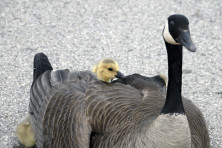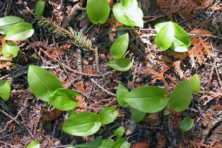DOOR TO NATURE: Canada Geese
- Share
- Tweet
- Pin
- Share

Someone asked me recently where all our Canada geese go in the winter. That’s sometimes a difficult question to answer. It depends on what kind of weather we have.
Our resident geese are the giant race, Branta canadensis, and they can endure some awful weather before they head south. We may find flocks staying here if it’s mild enough, with little snow cover and some waterways remaining open.
We used to marvel at hearing skeins of migrating Canada geese each autumn as they flew down from the far north. Most people don’t realize that there are 11 subspecies of the Canada goose. They range in size from not much bigger than the mallard duck to the giant race that breeds in Door County.
This species is probably shot more by hunters than any other bird. They are hunted through much of Canada and the United States, some for eight months of the year.
The four smallest types of Canada goose are now a distinct species known as the cackling goose, Branta hutchinsii. They tend to nest farther north, up to the Arctic Circle and well into Alaska. Darker colored Canada geese are seen in the western part of the continent.
The L.H. Barkhausen Waterfowl Preserve – located north of Green Bay along the western shore – began a breeding program in the mid-1970s to bring back the declining population of the giant race, and it increased the numbers of these huge honkers over the next 10 years. They were nearly extinct in the early 1900s.

Geese have legs that are set farther back on the body than the legs of ducks and swans, which enables geese to do more grazing on land. Some parks with large expanses of mowed lawns are favorite spots for geese to feed – and leave behind their big droppings. Sometimes the caretakers of parks or corporate ponds lay plastic mesh on the lawns to discourage the geese, and others have used border collies to chase away the flocks. If the grass is allowed to grow taller, that also discourages geese from eating there.
Nesting of the giant race has become common near water in much of Door County. The female builds her nest on a mound near the water’s edge in a slightly excavated area. She builds up coarse vegetation around the perimeter and then lines the nest with dry grasses and lots of down feathers to create a soft interior.
Females lay four to 10 eggs and incubate them for four weeks. This longer incubation period is typical when the young are precocial, meaning that they are up and running as soon as they hatch. The family stays together until later in the summer, when the adults have their postnuptial molt.
I remember seeing young that were just out of the eggs swimming with mom and dad in Kangaroo Lake by May 5 one year. Later that summer, we saw the two adults leading a troop of about 17 youngsters across the causeway, stopping traffic as they waddled slowly to the water on the other side. We learned that sometimes youngsters from another pair of parents are “adopted.”
Looking back to previous Northern Door Christmas bird counts, I noted that the first time when we had Canada geese was Dec. 20, 1980, with 50 being seen. None were seen in 1981, and only 17 in 1982. One was seen in 1983 and 1986. By Christmas of 1987, we counted 126 Canada geese. Numbers ranged from 17 to 425 over the next four years.
Once we began doing Christmas counts in the Sturgeon Bay area during the mid-1990s, Canada geese numbers increased. These were the giant race. Most migratory geese that flew over while heading south each fall were the smaller races that nest in Canada and spend the winter in the South. The range in numbers of Canada geese during the Sturgeon Bay counts is a low of 227 in 2008 – when we had frigid cold, heavy snow and frozen waterways – to a high of 6,168 in 2011, when the weather was warmer than usual.
One of my favorite books is Aldo Leopold’s A Sand County Almanac. His chapter on Canada geese and their wariness of humans makes some wise statements. Leopold wrote: “I once knew an educated lady, banded by Phi Beta Kappa, who told me that she had never heard or seen the geese that twice a year proclaim the revolving seasons to her well-insulated roof. Is education possibly a process of trading awareness for things of lesser worth? The goose who trades his [awareness] is soon a pile of feathers.”




